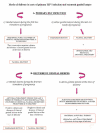Herpes simplex virus infection in pregnancy and in neonate: status of art of epidemiology, diagnosis, therapy and prevention
- PMID: 19348670
- PMCID: PMC2671497
- DOI: 10.1186/1743-422X-6-40
Herpes simplex virus infection in pregnancy and in neonate: status of art of epidemiology, diagnosis, therapy and prevention
Abstract
Herpes simplex virus (HSV) infection is one of the most common viral sexually transmitted diseases worldwide. The first time infection of the mother may lead to severe illness in pregnancy and may be associated with virus transmission from mother to foetus/newborn. Since the incidence of this sexually transmitted infection continues to rise and because the greatest incidence of herpes simplex virus infections occur in women of reproductive age, the risk of maternal transmission of the virus to the foetus or neonate has become a major health concern. On these purposes the Authors of this review looked for the medical literature and pertinent publications to define the status of art regarding the epidemiology, the diagnosis, the therapy and the prevention of HSV in pregnant women and neonate. Special emphasis is placed upon the importance of genital herpes simplex virus infection in pregnancy and on the its prevention to avoid neonatal HSV infections.
Figures
References
-
- Gupta R, Warren T, Wald A. Genital herpes. Lancet. 2007;22:2127–2137. - PubMed
Publication types
MeSH terms
Substances
LinkOut - more resources
Full Text Sources
Medical


